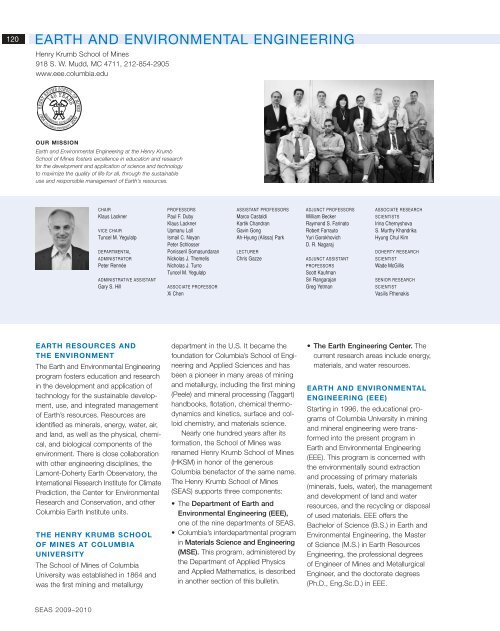2009-2010 Bulletin â PDF - SEAS Bulletin - Columbia University
2009-2010 Bulletin â PDF - SEAS Bulletin - Columbia University
2009-2010 Bulletin â PDF - SEAS Bulletin - Columbia University
You also want an ePaper? Increase the reach of your titles
YUMPU automatically turns print PDFs into web optimized ePapers that Google loves.
120<br />
EARTH AND ENVIRONMENTAL ENGINEERING<br />
Henry Krumb School of Mines<br />
918 S. W. Mudd, MC 4711, 212-854-2905<br />
www.eee.columbia.edu<br />
OUR MISSION<br />
Earth and Environmental Engineering at the Henry Krumb<br />
School of Mines fosters excellence in education and research<br />
for the development and application of science and technology<br />
to maximize the quality of life for all, through the sustainable<br />
use and responsible management of Earth’s resources.<br />
CHAIR<br />
Klaus Lackner<br />
VICE CHAIR<br />
Tuncel M. Yegulalp<br />
DEPARTMENTAL<br />
ADMINISTRATOR<br />
Peter Rennée<br />
ADMINISTRATIVE ASSISTANT<br />
Gary S. Hill<br />
PROFESSORS<br />
Paul F. Duby<br />
Klaus Lackner<br />
Upmanu Lall<br />
Ismail C. Noyan<br />
Peter Schlosser<br />
Ponisseril Somasundaran<br />
Nickolas J. Themelis<br />
Nicholas J. Turro<br />
Tuncel M. Yegulalp<br />
ASSOCIATE PROFESSOR<br />
Xi Chen<br />
ASSISTANT PROFESSORS<br />
Marco Castaldi<br />
Kartik Chandran<br />
Gavin Gong<br />
Ah-Hyung (Alissa) Park<br />
LECTURER<br />
Chris Gazze<br />
ADJUNCT PROFESSORS<br />
William Becker<br />
Raymond S. Farinato<br />
Robert Farrauto<br />
Yuri Gorokhovich<br />
D. R. Nagaraj<br />
ADJUNCT ASSISTANT<br />
PROFESSORS<br />
Scott Kaufman<br />
Sri Rangarajan<br />
Greg Yetman<br />
ASSOCIATE RESEARCH<br />
SCIENTISTS<br />
Irina Chernyshova<br />
S. Murthy Khandrika<br />
Hyung Chul Kim<br />
DOHERTY RESEARCH<br />
SCIENTIST<br />
Wade McGillis<br />
SENIOR RESEARCH<br />
SCIENTIST<br />
Vasilis Fthenakis<br />
EARTH RESOURCES AND<br />
THE ENVIRONMENT<br />
The Earth and Environmental Engineering<br />
program fosters education and research<br />
in the development and application of<br />
technology for the sustainable development,<br />
use, and integrated management<br />
of Earth’s resources. Resources are<br />
identified as minerals, energy, water, air,<br />
and land, as well as the physical, chemical,<br />
and biological components of the<br />
environment. There is close collaboration<br />
with other engineering disciplines, the<br />
Lamont-Doherty Earth Observatory, the<br />
International Research Institute for Climate<br />
Prediction, the Center for Environmental<br />
Research and Conservation, and other<br />
<strong>Columbia</strong> Earth Institute units.<br />
THE HENRY KRUMB SCHOOL<br />
OF MINES AT COLUMBIA<br />
UNIVERSITY<br />
The School of Mines of <strong>Columbia</strong><br />
<strong>University</strong> was established in 1864 and<br />
was the first mining and metallurgy<br />
department in the U.S. It became the<br />
foundation for <strong>Columbia</strong>’s School of Engineering<br />
and Applied Sciences and has<br />
been a pioneer in many areas of mining<br />
and metallurgy, including the first mining<br />
(Peele) and mineral processing (Taggart)<br />
handbooks, flotation, chemical thermodynamics<br />
and kinetics, surface and colloid<br />
chemistry, and materials science.<br />
Nearly one hundred years after its<br />
formation, the School of Mines was<br />
renamed Henry Krumb School of Mines<br />
(HKSM) in honor of the generous<br />
<strong>Columbia</strong> benefactor of the same name.<br />
The Henry Krumb School of Mines<br />
(<strong>SEAS</strong>) supports three components:<br />
• The Department of Earth and<br />
Environmental Engineering (EEE),<br />
one of the nine departments of <strong>SEAS</strong>.<br />
• <strong>Columbia</strong>’s interdepartmental program<br />
in Materials Science and Engineering<br />
(MSE). This program, administered by<br />
the Department of Applied Physics<br />
and Applied Mathematics, is described<br />
in another section of this bulletin.<br />
• The Earth Engineering Center. The<br />
current research areas include energy,<br />
materials, and water resources.<br />
EARTH AND ENVIRONMENTAL<br />
ENGINEERING (EEE)<br />
Starting in 1996, the educational programs<br />
of <strong>Columbia</strong> <strong>University</strong> in mining<br />
and mineral engineering were transformed<br />
into the present program in<br />
Earth and Environmental Engineering<br />
(EEE). This program is concerned with<br />
the environmentally sound extraction<br />
and processing of primary materials<br />
(minerals, fuels, water), the management<br />
and development of land and water<br />
resources, and the recycling or disposal<br />
of used materials. EEE offers the<br />
Bachelor of Science (B.S.) in Earth and<br />
Environmental Engineering, the Master<br />
of Science (M.S.) in Earth Resources<br />
Engineering, the professional degrees<br />
of Engineer of Mines and Metallurgical<br />
Engineer, and the doctorate degrees<br />
(Ph.D., Eng.Sc.D.) in EEE.<br />
<strong>SEAS</strong> <strong>2009</strong>–<strong>2010</strong>







